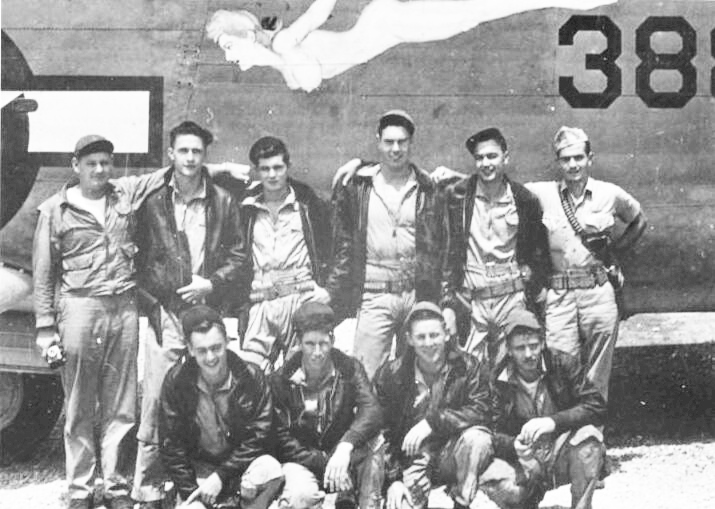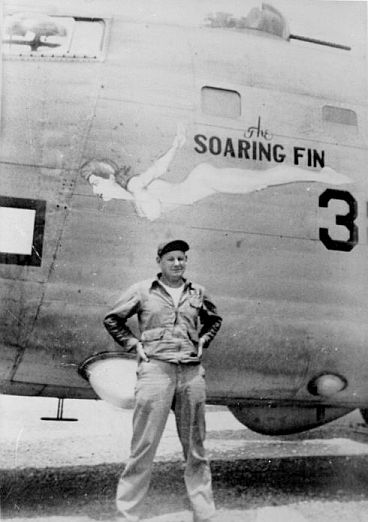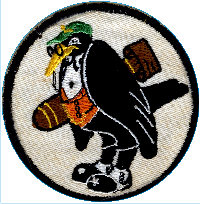Crew 6, U.S. Navy PB4Y-2 "Privateer" Patrol Bomber Squadron VPB-118
Information recounted here was obtained from the VPB-118 book, "The Old Crows, VPB-118, The History of Navy Patrol Bombing Squadron 118." Most of the crew names were compiled by James Pettit. Crew photo courtesy James Pettit of VPB-118.

Crew 6 in front of BuNo 59388, "The Soaring Fin" (Courtesy James Pettit)
PPC Lt. Robert M.Finley
Crew 6 of VPB-118 consisted of:(Back L-R) Lt. Robert M. Finley, PPC, Harold W. Childs ARM2c (starboard waist gunner, then 2nd radio after being replaced by Carl Seimers, bombardier), Eugene T. Johnston AMM2c (3rd mechanic, aft top turret), J.B. Pryor AMM2c (2nd mechanic, port waist turret), Jack H. Lindell, Jr. ARM1c (first radio), Lt. (jg) Charles Fernandez (co-pilot)
(Front L-R) Carl Seimers, Jr. AOMB2c (bombardier, then starboard waist gunner after bombsight eliminated), Alex Trahan AMM3c (4th mechanic, tail turret), Fred Grochmal AMM2c (plane captain, forward top turret), C.C. Keith AOM2c (1st Ordnanceman, bow turret) as well as Ens. John B. Abeln (co-pilot, not in photo)
On 8/20/1944, members of this crew and Crew 2 (PPC Dodson) were the first crews to be assigned the new PB4Y-2 Privateer. Crew Six's plane, BuNo 59388 received nose art from an enlisted man named Rape and was dubbed “The SOARING FIN”. Beginning in January, 1945 Crew 6 was stationed on Tinian Island and executed 1000-mile fleet coverage patrols for Task Force 58 during the battle for Iwo Jima. After the capture of Iwo Jima, patrols were extended out to reach the coastal waters of Japan and Okinawa. Returning from such a patrol on March 9, Crew 6 encountered head-on a formation of 334 B-29 bombers that were flying unannounced out of concern for secrecy. PPC Finley flew two tense hours through the formation before the last B-29 was seen. On March 21 Ens. John Abeln (co-pilot/navigator) was seriously injured in a freak runway accident when he was struck in the head by an idling propeller after an aborted take-off.
Starting May 2, Crew 6 was based on Okinawa, from where they mainly flew search and destroy missions as part of the blockade of Japan. Their main targets were tankers, freighters, and picket boats. On May 4, they strafed a 2500-ton tanker. During one strafing run PPC Finley dodged debris when the tanker's stern exploded. Despite severe damage to the tanker it did not sink, requiring PPC Finley to sink it with a perfect bomb strike to the hull. On May 6, Crew 6 and wing Crew 17 (PPC Thompson) sank a 5200-ton tanker after 2 tries with 500 lb. bombs, the 2nd attempt completely destroying the boat. Immediately afterwards they sank a 4000-ton freighter, followed directly by a 10,000-ton tanker, which was anchored next to a steep cliff. Despite AA fire from the shore, PPC Finley made the first bombing/strafing run on the 10,000-ton tanker, which resulted in a direct bomb hit and effective strafing by bow gunner C.C. Keith. As wingman PPC Thompson made his run, the tanker shot up a 1,000-foot column of flame, which caused Thompson to sharply bank his plane, between the cliff and the inferno. At the end of this same patrol, a 1000-ton freighter with an active 3-inch gun was encountered, but one dud and one hung-up bomb spared it. For the actions on May 4 & 6, PPC Finley received the Navy Cross and the rest of the aircrew received a Distinguished Flying Cross and an Air Medal.
On May 16, Crew 6 flew wing to Crew 7 (PPC Farwell) on a patrol to the Tsushima Straits. After an unsuccessful rescue search, they were intercepted by 2 Japanese “Jacks” (Mitsubishi Raiden navy interceptor with four 20mm wing cannons). From 2 miles out, they initiated the first clash between Japan’s new interceptor and the new U.S. PB4Y-2. The 2 Jacks took turns with high-speed diving attacks, countered by evasive weaving by the 2 Privateers, bow and top turrets blazing. The Jacks made unsuccessful bomb runs on the patrol, then strafing runs. On its strafing run, one of the Jacks received engine damage, smoked, and flew directly away. Each PB4Y-2 plane took one 20mm round. The patrol dumped their bombs and sped to 200 knots. Two more Jacks intercepted them and also made unsuccessful bomb runs, followed by strafing runs in which all the bow and top turret gunners of the 2 Privateers bore down on them with their twin .50 guns. Both Jacks crashed into the sea. For this action the crew received the Air Medal.
On June 6, Crew 6 participated in a 6-plane mine-laying mission which encountered first picket boats, then numerous destroyers and destroyer escorts. After being driven away from Fusan (now “Pusan”) Harbor by heavy AA fire they dropped their mines at an alternate target. Five of the six planes were damaged by the AA.
On July 4, Crew 6 took part in a convoy raid with two other VPB-118 crews, several PBM's, and several P-47's. While the VPB-118 crews did not have the opportunity to make any bomb runs, they provided an essential diversion while the other planes made rocket and torpedo runs. Upon returning, bow gunner C.C. Keith found a hole and markings on the bomb bay door that apparently showed that they had survived a direct hit by a dud 3" AA round.
On July 21, Crew 6, along with Crew 4, flew a patrol to the east coast of Kyushu. On their outbound and inbound legs they saw a submarine, which they did not attack. Upon returning to base, Lt. Finley got confirmation that it was not a U.S. sub, and returned and sank it without help from Crew 4, whose plane's engines wouldn't start. Admiral Halsey sent a congratulatory dispatch upon confirmation.
On August 9, Crews 6 & 4 flew a search and harass mission in support of submarine activity. They were told to stay away from Nagasaki, 30 miles from the sector they were flying; they weren't told that the atomic bomb drop was taking place at that time. Bow gunner C.C. Keith told me that Crew 6 flew a total of 48 missions. On August 18, Crew 6 and Crew 16 left Okinawa on BuNo 59410, “Miss Lottatail” to return to Hawaii and then the States.

PPC Finley in front of his plane, "The SOARING FIN" (BuNo 59388). Photo courtesy of Robert Finley's daughter, Ruth Barry.
